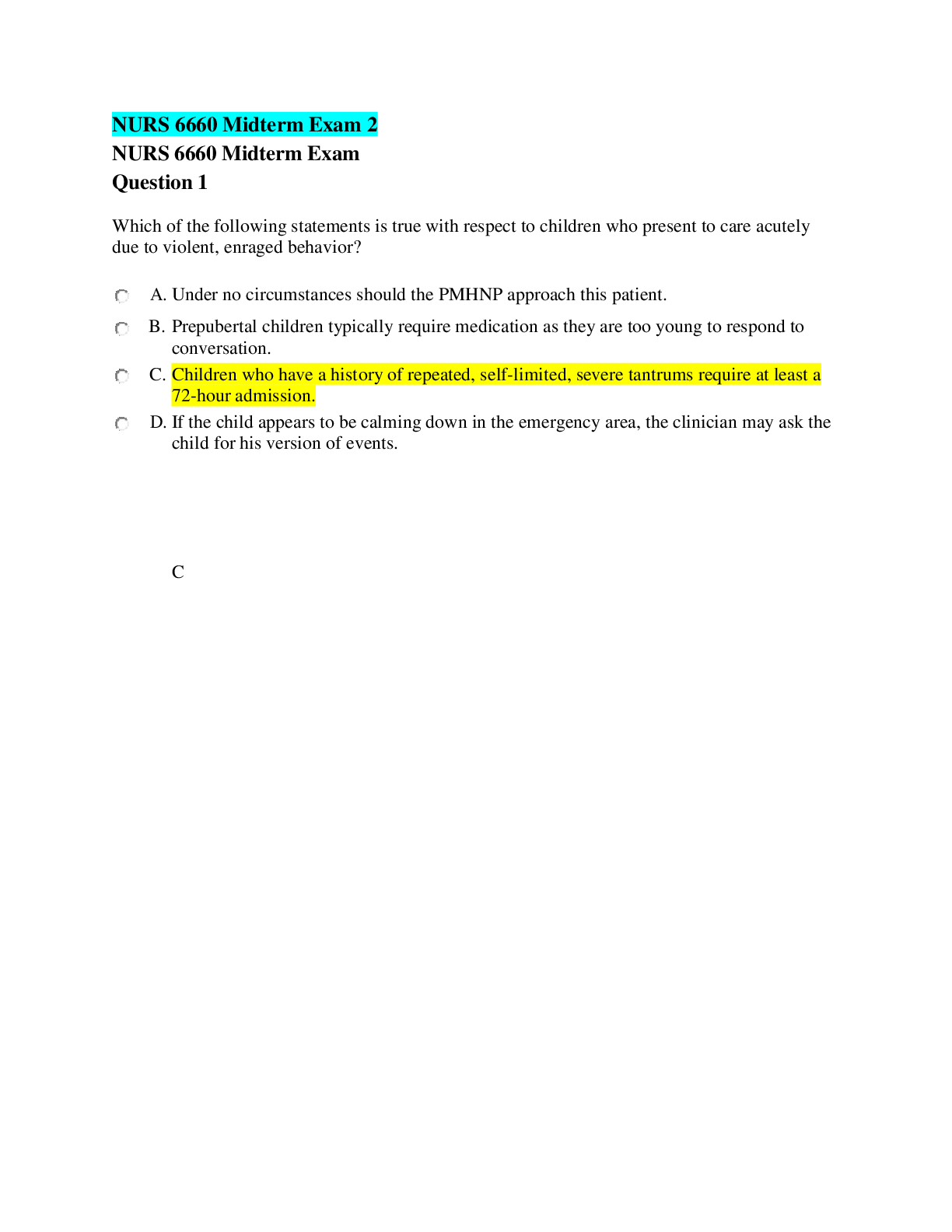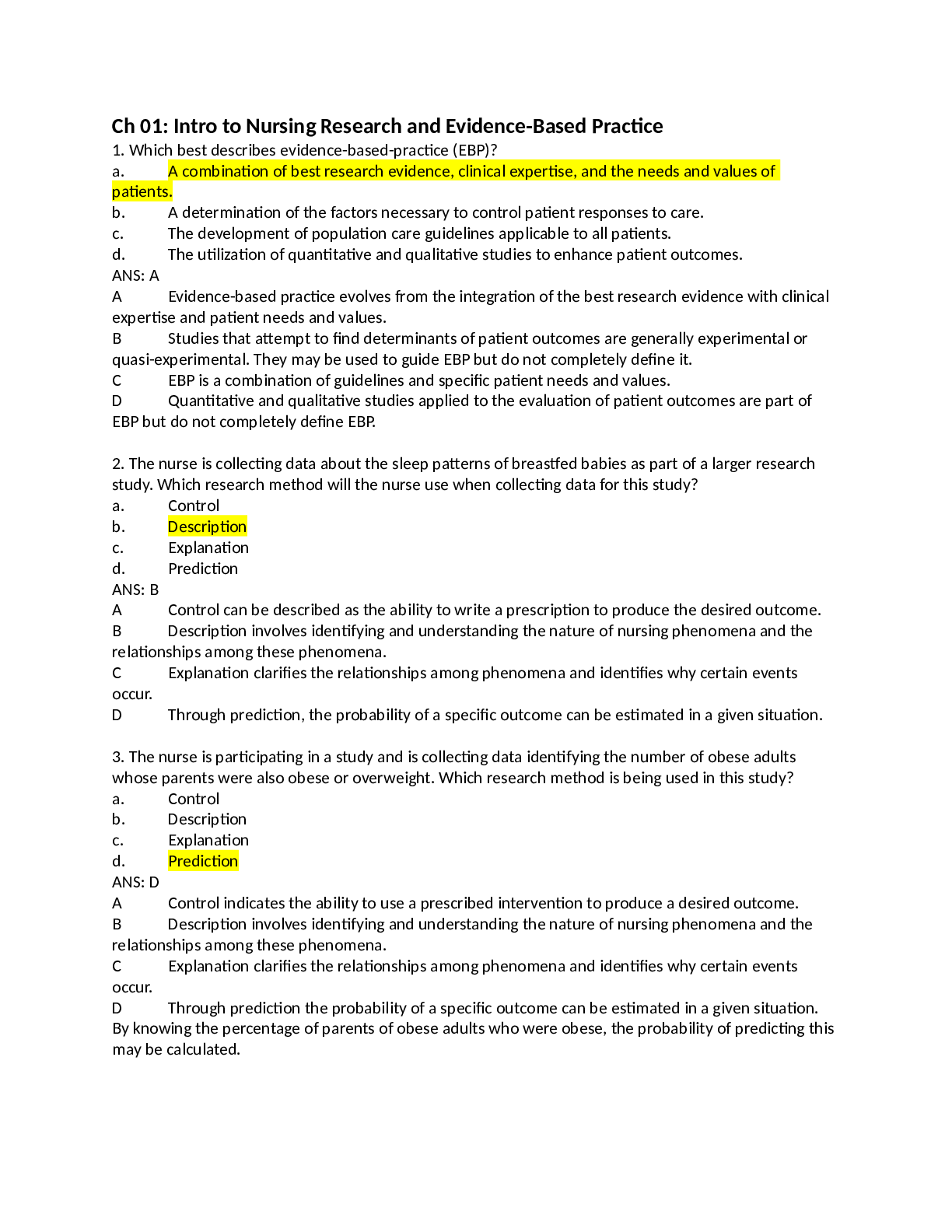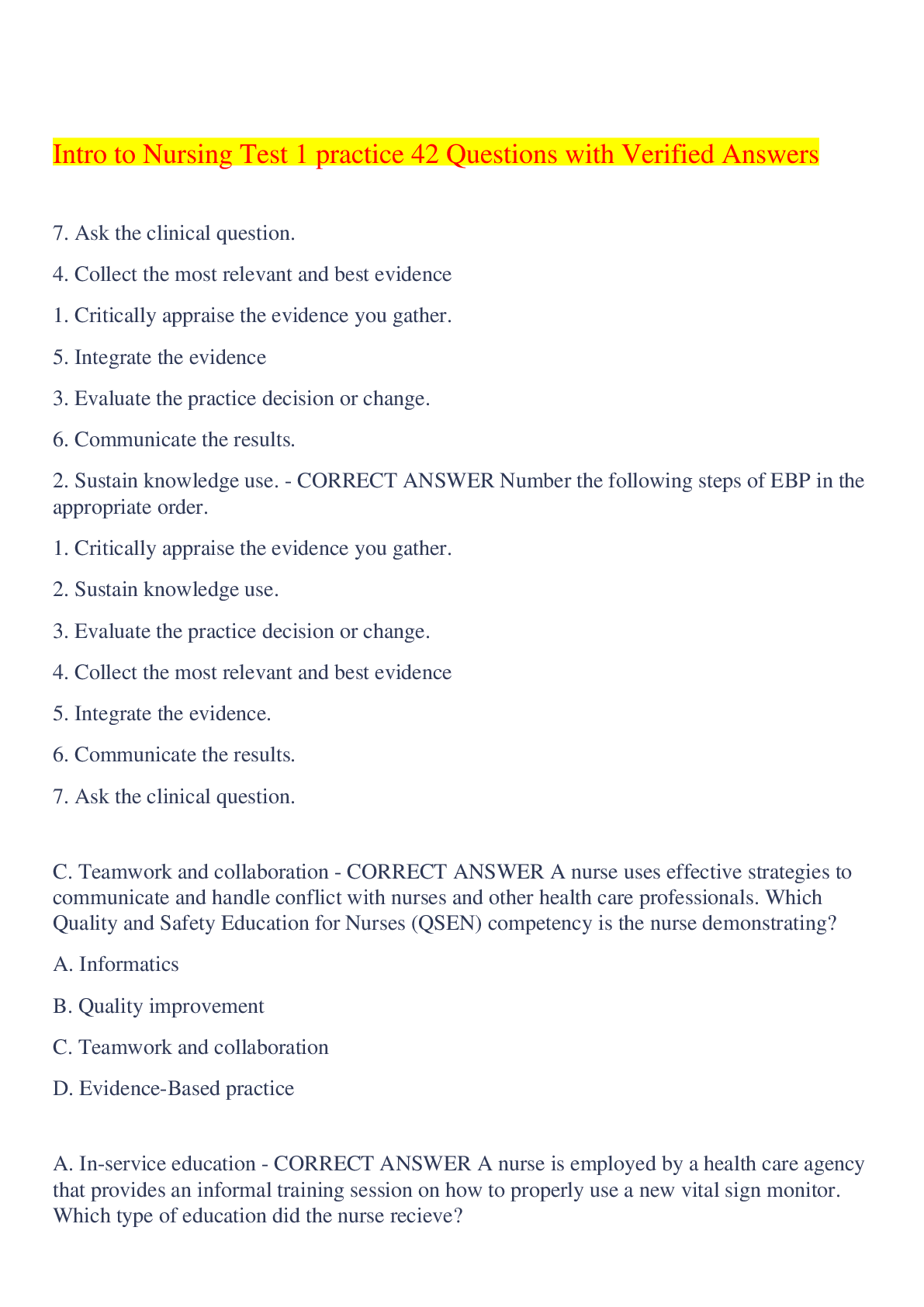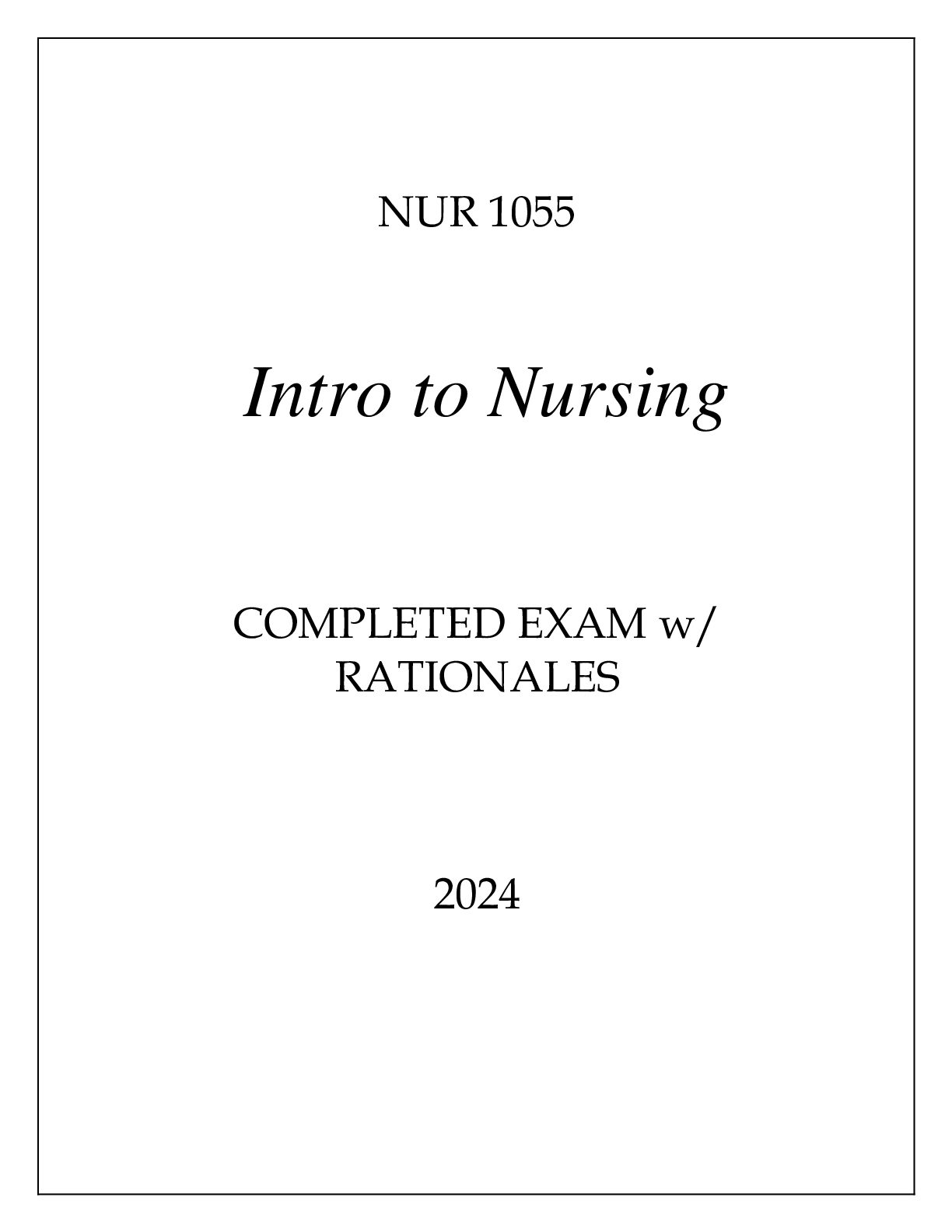Health Care > EXAM > HLTH 501 Intro to Nursing Exam 3 Answered. (All)
HLTH 501 Intro to Nursing Exam 3 Answered.
Document Content and Description Below
Intro to Nursing Exam 3 1. The purpose of infection control is to prevent the spread of infections and pathogens. a. True b. False True 2. Medical records are legal documents that can be used as ... evidence in court. a. Tr ue b. Fa ls e Tr ue 3. Medical charting should be done in pencil because mistakes can be more easily and neatly corrected. a. Tr ue b. Fa ls e Fa ls e 4. Incomplete documentation can result in denial of payment to health providers by insurance companies. a. Tr ue b. Fa ls e Tr ue 5. Faxes are a good way to efficiently send patient records to another provider. a. Tr ue b. Fa 6. Infectious diseases are caused by the decrease in growth of pathogens. a. True b. False 7. An epidemic is the widespread occurrence of infectious disease globally. a. True b. False 8. Signs of a generalized systemic infection is fever, vomiting and fatigue. a. True b. False True 9. Mr. Jones was experiencing redness, swelling and pain from his systemic infection. a. True b. False 10. Aerobic microorganisms need oxygen to live. a. True b. False True 11. Anaerobic microorganisms need oxygen to live. a. True b. False 12. Bacteria is only made up of single and chain clusters. a. True b. False False 13. Yeast are multicellular organisms. a. True b. False False 14. One way to identify the type of bacteria is by gram staining. a. True b. False 15. Fungi are a small animal that can only be seen under a microscope. a. True b. False False 16. The chain of infection must be kept intact to stop an infection from being transmitted. a. True 17. Class A fire extinguishers should never be used on fires that involve flammable liquids. a. True b. False 18. In the event of a fire, a hot door should be opened if it is the only escape route. a. True b. False 19. Chemicals should never be stored near a heat source or in direct sunlight. a. True b. False 20. Workplace violence is lower in health care settings than in other work settings. a. True b. False 21. Identify the five pathogenic microorganisms. (select all that apply) a. Bacteria b. Algae c. Fungi d. Protozoa e. Rickettsia f. Mold g. Virus ) 22. The smallest type of microbes is: a. Viruses b. Rickettsia c. Bacteria d. Protozoa 23. Which of the following would cause athlete’s foot? a. Worm b. Virus c. Fungi d. Yeast 24. The body has _______to defend the respiratory tract. a. Meninges b. Leukocytes c. Agent d. Cilia 25. Which of the following is NOT correct in the link of the chain of infection? b. Reservoir host c. Portal of exit d. Route of diffusion e. Portal of entry f. Susceptible host Ans: D 26. Identify the meaning of RACE in a fire (Answer is 5 choices). a. Remove b. Activate alarm c. Continue d. Extinguish or e. Contain f. Exit or g. Evacuate or 27. When using a fire extinguisher, at which part of the fire should the nozzle be aimed? a. Top section of the flames b. Middle section of the flames c. The base of the flames d. Up and down the height of the flames Ans: C 28. What is the advantage of using an ABC type of fire extinguisher? a. It is the easiest to operate b. It does not leave a skin-irritating residue. c. It extinguishes fires the most quickly. d. It can be used on all types of fires. 29. Which is the correct way to document a patient’s statement about symptoms experienced? a. Write direct quotes and enclose the entry in quotation marks. b. Write the statement in your own words. c. Note the statement in a shortened form, using standard abbreviations. d. List the symptoms, using correct medical terminology. 30. How should the health care professional select appropriate abbreviations to use in written documentation? a. Create personal abbreviations that are clear. b. Refer to a standard medical dictionary. c. Use those learned in medical terminology courses. d. Follow facility policies. Ans: D 31. Which of the following personnel may write progress notes that are included in the patient’s official medical record? b. Only nurses c. Only physicians and nurses d. Any health care professional who provides a direct service to the patient 32. Which of the following is a purpose for medical documentation? a. Prevents malpractice lawsuits b. Prevents cost overruns c. Communicates directly with the patient d. Helps ensure compliance with regulatory agencies 33. Which of the following items would be included in the personal history? a. Allergies b. Smoking history c. Family tendency for problems d. Use of illegal drugs Ans: A 34. Which order is most frequently used for conducting complete physical examinations? a. From head to toe b. From trunk to arms and legs c. From feet to head d. From arms and legs to trunk 35. Which of the following is the most fundamental skill on which to base good health care observational skills? a. Recognizing the signs of disease b. Understanding normal anatomy and physiology c. Learning diagnostic skills d. Knowing how to correctly read the patient’s chart 36. When a health care professional is noting the gait of a patient, what are they observing? a. Manner of walking b. Speech pattern c. How well they hear d. If they are hydrated Ans: A 37. When working with patients who have orthostatic hypotension, it is important to: a. make sure they take blood pressure medication. b. test for apical‒radial deficit. c. check their blood pressure frequently. . 38. What instrument is used to measure a patient’s blood pressure? a. A Blood Pressure Cuff b. A Monitor c. Sphygmomanometer d. Sphygmamanoscope 39. What does it mean when a patient reports his pain dropping from 8 to 2 after receiving pain medication? a. The medication has been effective. b. The patient did not need the medication. c. The medication regimen needs to be reevaluated. d. The pain cannot be controlled. 40. Why are electrical fires especially hazardous? a. There is the danger of electrocution. b. They burn and spread more quickly. c. They are difficult to put out. d. Fire extinguishers cannot be used on them. Ans: A 41. In the event of a fire in which smoke is present, what is the safest way to leave the area? a. Take the shortest route and run as quickly as possible. b. Walk as close to the walls as possible. c. Keep the head upright and above the smoke. d. Crawl along the floor. 42. What is the first step to take if a person is receiving an electrical shock? a. Call for help. b. Pull the victim away from the source of power. c. Unplug the device causing the shock. d. Turn off the main source of power. [Show More]
Last updated: 5 months ago
Preview 2 out of 7 pages

Loading document previews ...
Buy this document to get the full access instantly
Instant Download Access after purchase
Buy NowInstant download
We Accept:

Reviews( 0 )
$9.00
Can't find what you want? Try our AI powered Search
Document information
Connected school, study & course
About the document
Uploaded On
Feb 20, 2020
Number of pages
7
Written in
Additional information
This document has been written for:
Uploaded
Feb 20, 2020
Downloads
0
Views
139

























